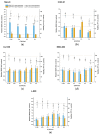Pulsed Electric Fields Alter Expression of NF-κB Promoter-Controlled Gene
- PMID: 35008875
- PMCID: PMC8745616
- DOI: 10.3390/ijms23010451
Pulsed Electric Fields Alter Expression of NF-κB Promoter-Controlled Gene
Abstract
The possibility to artificially adjust and fine-tune gene expression is one of the key milestones in bioengineering, synthetic biology, and advanced medicine. Since the effects of proteins or other transgene products depend on the dosage, controlled gene expression is required for any applications, where even slight fluctuations of the transgene product impact its function or other critical cell parameters. In this context, physical techniques demonstrate optimistic perspectives, and pulsed electric field technology is a potential candidate for a noninvasive, biophysical gene regulator, exploiting an easily adjustable pulse generating device. We exposed mammalian cells, transfected with a NF-κB pathway-controlled transcription system, to a range of microsecond-duration pulsed electric field parameters. To prevent toxicity, we used protocols that would generate relatively mild physical stimulation. The present study, for the first time, proves the principle that microsecond-duration pulsed electric fields can alter single-gene expression in plasmid context in mammalian cells without significant damage to cell integrity or viability. Gene expression might be upregulated or downregulated depending on the cell line and parameters applied. This noninvasive, ligand-, cofactor-, nanoparticle-free approach enables easily controlled direct electrostimulation of the construct carrying the gene of interest; the discovery may contribute towards the path of simplification of the complexity of physical systems in gene regulation and create further synergies between electronics, synthetic biology, and medicine.
Keywords: NF-κB; cell line; inducible gene transcription control; mammalian cells; microsecond pulsed electric field; reporter assay; secreted alkaline phosphatase.
Conflict of interest statement
The authors declare no conflict of interest.
Figures




Similar articles
-
Generation of stably transfected Mammalian cell lines as fluorescent screening assay for NF-kappaB activation-dependent gene expression.J Biomol Screen. 2003 Oct;8(5):511-21. doi: 10.1177/1087057103257204. J Biomol Screen. 2003. PMID: 14567778
-
A NF-kappa B/Sp1 region is essential for chromatin remodeling and correct transcription of a human granulocyte-macrophage colony-stimulating factor transgene.J Immunol. 2001 Jul 1;167(1):302-10. doi: 10.4049/jimmunol.167.1.302. J Immunol. 2001. PMID: 11418664
-
Tumor necrosis factor modulates transcription of myelin basic protein gene through nuclear factor kappa B in a human oligodendroglioma cell line.Int J Dev Neurosci. 2002 Jun-Aug;20(3-5):289-96. doi: 10.1016/s0736-5748(02)00022-9. Int J Dev Neurosci. 2002. PMID: 12175864
-
Melanoma differentiation-associated gene-7/IL-24 gene enhances NF-kappa B activation and suppresses apoptosis induced by TNF.J Immunol. 2004 Oct 1;173(7):4368-76. doi: 10.4049/jimmunol.173.7.4368. J Immunol. 2004. PMID: 15383566
-
Identification of a nuclear factor kappa B-dependent gene network.Recent Prog Horm Res. 2003;58:95-130. doi: 10.1210/rp.58.1.95. Recent Prog Horm Res. 2003. PMID: 12795416 Review.
Cited by
-
Microsecond pulsed electric fields induce myocardial ablation by secondary mitochondrial damage and cell death mechanisms.Sci Rep. 2025 Mar 24;15(1):10132. doi: 10.1038/s41598-025-94868-4. Sci Rep. 2025. PMID: 40128377 Free PMC article.
-
Electrical Stimulation Therapy - Dedicated to the Perfect Plastic Repair.Adv Sci (Weinh). 2025 Jun;12(24):e2409884. doi: 10.1002/advs.202409884. Epub 2024 Dec 16. Adv Sci (Weinh). 2025. PMID: 39680745 Free PMC article. Review.
-
Modulation of inflammatory response by electromagnetic field in Neuronal and Microglial cells.J Surg Res (Houst). 2025;8(3):305-312. doi: 10.26502/jsr.10020453. Epub 2025 Jul 2. J Surg Res (Houst). 2025. PMID: 40778000 Free PMC article.
-
Development of Chitosan/Gelatin-Based Hydrogels Incorporated with Albumin Particles.Int J Mol Sci. 2022 Nov 16;23(22):14136. doi: 10.3390/ijms232214136. Int J Mol Sci. 2022. PMID: 36430612 Free PMC article.
-
Microphysiological system with integrated sensors to study the effect of pulsed electric field.Sci Rep. 2024 Aug 12;14(1):18713. doi: 10.1038/s41598-024-69693-w. Sci Rep. 2024. PMID: 39134607 Free PMC article.
References
-
- Stuible M., Burlacu A., Perret S., Brochu D., Paul-Roc B., Baardsnes J., Loignon M., Grazzini E., Durocher Y. Optimization of a high-cell-density polyethylenimine transfection method for rapid protein production in CHO-EBNA1 cells. J. Biotechnol. 2018;281:39–47. doi: 10.1016/j.jbiotec.2018.06.307. - DOI - PubMed
MeSH terms
Substances
Grants and funding
LinkOut - more resources
Full Text Sources

